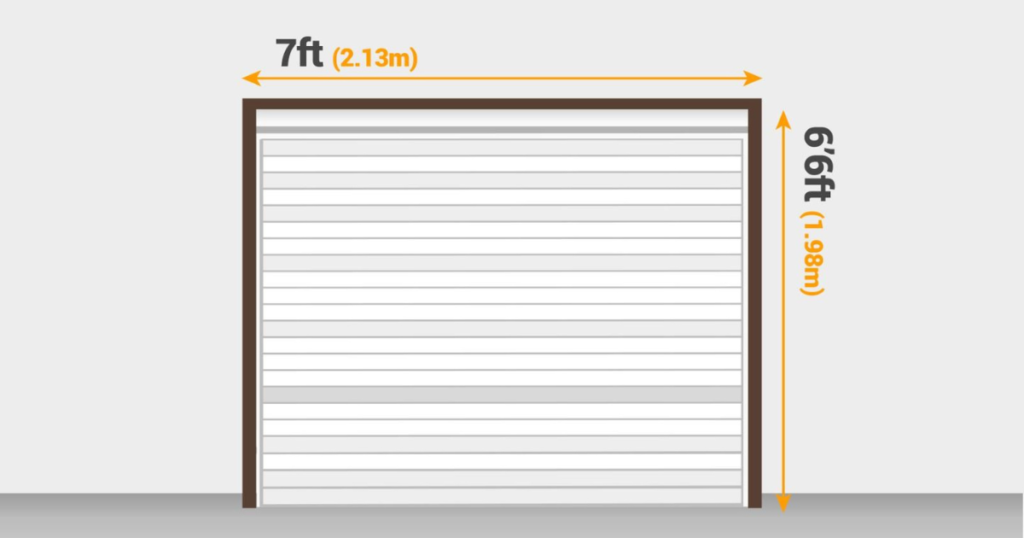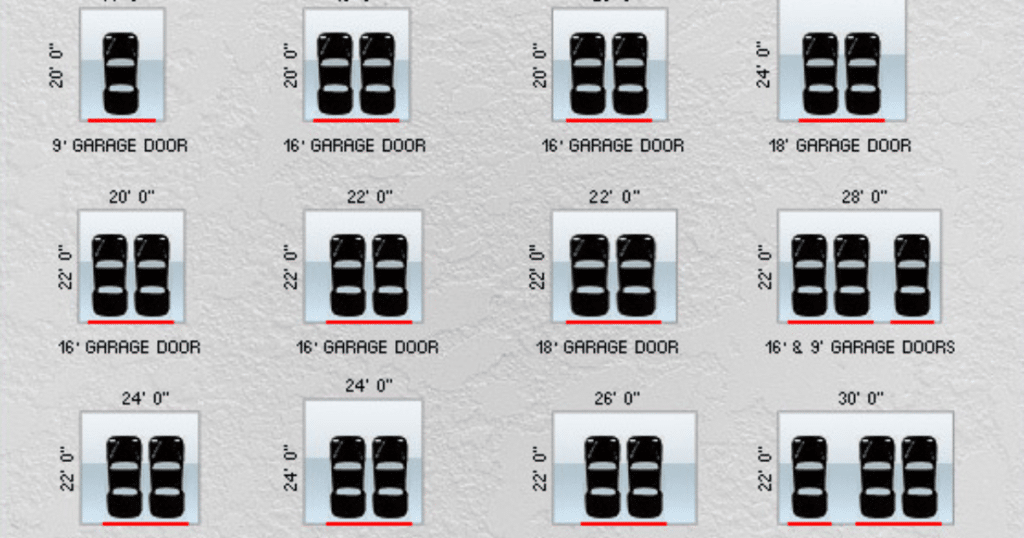How wide is a single garage door? Whether you’re building, replacing, or just curious, here’s everything you need to know before deciding.
The width is one of the most important specs when choosing or replacing a garage door. So, how wide is a single garage door? In most homes across the U.S., a standard single garage door is typically 8 to 9 feet wide, with a standard height of 7 to 8 feet. This size is designed to fit a standard vehicle, such as a car, SUV, or small truck.
If you drive a larger vehicle or need extra storage space on the sides, opting for a wider single door around 10 feet might be a better fit. Always measure your garage opening and consider how you use the space before deciding.

Residential Garage Standards: Why Sizes Vary
While the standard sizing gives a general idea, homeowners should be aware that garage door sizes can vary depending on:
- Home layout and architectural design: The original blueprint of a home plays a major role in determining garage size. Attached versus detached garages, multi-car setups, and the available square footage can all affect what size garage door is appropriate or even possible.
- Local building codes and zoning regulations: Municipal codes may set specific requirements for garage dimensions, especially in densely populated areas. These regulations ensure safety, uniformity, and compliance with neighborhood standards, which may limit your options or require permits for modifications.
- Personal vehicle type and lifestyle: The kind of vehicles you own—or plan to own—also shapes your garage needs. Compact cars, SUVs, trucks, or recreational vehicles require different amounts of space. Additionally, if you use your garage for storage, a workshop, or hobbies, that space may need to be wider or taller than standard options.
Older homes, particularly those built in the mid-20th century or earlier, often have narrower garage openings, typically closer to 7 feet wide. These were designed with smaller vehicles in mind and may not comfortably accommodate today’s larger cars or SUVs. In contrast, newer construction homes often feature wider and taller garage doors—sometimes up to 9 or even 10 feet wide—to offer more flexibility, ease of access, and room for larger modern vehicles.
If you plan to replace an existing garage door, it’s essential to take precise measurements of the opening and assess clearance on both sides, above and behind the door. This ensures the new installation will function properly and avoid any costly surprises. Consulting a professional can also help you determine what door size best fits your home’s design and practical needs.
In short, while standard sizes exist, a “standard” garage door might not be the right fit for your unique situation. Understanding why sizes vary can help you make the best decision for your home.
Choose Smart: Is a Wider Single Door Right for You?
Choosing how wide your single garage door should be depends on your lifestyle. Here are factors to consider:
- Do you own a large vehicle?
If you drive a full-size SUV, truck, or van, a wider door—such as a 10-foot-wide option—can make a big difference in ease and comfort. It reduces the risk of accidentally scraping mirrors or struggling to open doors inside a tight space. A wider door also comes in handy if you ever upgrade to a larger vehicle.
- Do you need side storage space?
Garages often double as storage areas for bikes, lawn equipment, tools, or seasonal gear. Choosing a slightly wider garage door can help preserve interior storage along the sides without making vehicle access feel cramped. That extra foot or two can mean the difference between neatly storing gear or constantly rearranging things.
- Is your garage attached or detached?
The structure and layout of your garage can influence the appropriate door width. Attached garages often align with the home’s exterior and may have restrictions due to available wall space or property lines. Detached garages, on the other hand, might offer more freedom to expand width or height, especially if designed from the ground up. Your door width should complement the garage’s overall design and placement.
- How do you use your garage day-to-day?
Beyond parking, think about how you move within the space. Do you carry groceries in and out regularly? Work on home projects? Let kids access bikes or toys? A wider door can make everyday tasks more convenient and reduce the need to maneuver around tight corners or obstacles constantly.
Thinking through how you use your garage daily will help determine the ideal width without over-investing in unnecessary space.
How to Measure Your Garage for a New Door
Knowing how wide is a single garage door starts with measuring your own. Here’s a simple guide to take accurate measurements:
- Width (Opening Width): Measure the distance between the inside edges of the finished garage door opening. Be sure to measure in a straight, horizontal line at the widest point. This gives you the actual opening size your new door needs to cover.
- Height (Opening Height): Measure from the garage floor to the top of the finished opening. Again, take the measurement straight up and down. Be sure the floor is level ,and the header isn’t sagging—these can affect the final fit.
- Side Room (Side Clearance): Check the amount of wall space available on each side of the opening. Most garage door systems require at least 3.5 inches on both the left and right to accommodate the tracks and hardware. More space may be needed for doors with automatic openers or special features.
- Headroom (Top Clearance): Measure from the top of the garage opening to the ceiling or any obstructions above. Standard garage door openers typically require at least 12 inches of headroom. Some low-clearance kits are available if your space is tight, but knowing your clearance is key.
- Backroom (Depth): Measure from the front of the opening straight back to the rear wall of the garage. You’ll need enough space to fully accommodate the door’s height as it opens and rolls back along the ceiling. A good rule of thumb is the standard systems’ door height plus 18 inches.
Accurate, detailed measurements help ensure that your garage door will fit your space functionally and visually. They also help you avoid costly surprises during installation, especially if you’re upgrading to a wider or taller door. If you’re unsure or your garage has unusual features (like sloped floors, low ceilings, or exposed beams), it’s a good idea to consult a professional installer to verify your numbers.
With the right measurements, you’ll be confidently exploring door sizes, styles, and opener systems.
When Custom Is the Better Option
Some homeowners have unique layouts that require non-standard sizes. A custom-sized new garage door may be necessary if your current opening doesn’t match any traditional widths. Custom doors allow you to maximize space, improve functionality, and enhance curb appeal without compromising structure.
Although custom doors can increase the overall project cost, the benefits of a perfect fit and better long-term performance are worth considering.

Frequently Asked Questions About Single Garage Door Widths
How wide is a single garage door in new construction?
Most new homes include garage doors that are 9 feet wide by 7 feet tall, which fits most passenger vehicles comfortably.
Can I make my existing garage door wider?
Yes, but this requires structural modifications. Consult a garage door professional on garage door repair or contractor to ensure your garage can handle a wider door.
What is the minimum width for a single-car garage door?
The minimum width is generally 8 feet, though older homes may have doors as narrow as 7 feet.
Is a 10-foot single garage door better than a 9-foot one?
A 10-foot door offers more clearance, which is helpful for larger vehicles or added side storage, but it’s not always necessary.
Are single garage doors customizable?
Yes. You can order custom widths and heights of single garage doors to fit your space and style requirements.
Conclusion
Understanding how wide is a single garage door helps homeowners make confident, practical decisions. Whether you’re planning a remodel or building new, knowing standard sizing ensures your investment is compatible with your vehicle size and lifestyle.
Choosing the correct width prevents clearance issues and improves everyday usability. Don’t settle for assumptions—measure your space and explore options that best suit your home and habits..
End Note
DoorJam Garage Repair delivers expert solutions for homeowners across Raleigh, Durham, and Wake Forest find the perfect garage door for their property. Whether you’re looking for a standard or custom solution, our expert technicians are equipped to deliver results you can rely on.
Our new garage door replacement services are designed around precision, quality, and long-term satisfaction. We understand that each home is unique, and our tailored approach ensures that your new garage door effortlessly complements your property’s architecture.
Learn more about our team, browse our list of garage door services, or reach out directly through our contact page. Want to stay connected? Follow us on Facebook and Instagram to see our latest projects and updates.
